Effect of Ionic Compounds of Different Valences on the Stability of Titanium Oxide Colloids
Abstract
:1. Introduction
2. Stability of Titanium Oxide Particles in Electrolyte Solutions
2.1. General Considerations
2.2. Effect of pH on Charging and Aggregation
2.3. Colloidal Stability in the Presence of Monovalent Electrolytes
2.4. Multivalent Ion-Induced Aggregation
3. Charging and Aggregation of Titanium Oxide Materials in the Presence of Polymers
3.1. General Remarks
3.2. Oppositely Charged Particle-Polyelectrolyte Systems
3.3. Effect of Like-Charged Polyelectrolytes on the Stability of Titanium Oxide Dispersions
4. Conclusions
Author Contributions
Funding
Conflicts of Interest
References
- Wang, L.Z.; Sasaki, T. Titanium Oxide Nanosheets: Graphene Analogues with Versatile Functionalities. Chem. Rev. 2014, 114, 9455–9486. [Google Scholar] [CrossRef] [PubMed]
- Kment, S.; Riboni, F.; Pausova, S.; Wang, L.; Wang, L.Y.; Han, H.; Hubicka, Z.; Krysa, J.; Schmuki, P.; Zboril, R. Photoanodes Based on TiO2 and Alpha-Fe2O3 for Solar Water Splitting—Superior Role of 1d Nanoarchitectures and of Combined Heterostructures. Chem. Soc. Rev. 2017, 46, 3716–3769. [Google Scholar] [CrossRef] [PubMed]
- YazdanYar, A.; Aschauer, U.; Bowen, P. Interaction of Biologically Relevant Ions and Organic Molecules with Titanium Oxide (Rutile) Surfaces: A Review on Molecular Dynamics Studies. Colloid Surf. B 2018, 161, 563–577. [Google Scholar] [CrossRef] [PubMed]
- Kukovecz, A.; Kordas, K.; Kiss, J.; Konya, Z. Atomic Scale Characterization and Surface Chemistry of Metal Modified Titanate Nanotubes and Nanowires. Surf. Sci. Rep. 2016, 71, 473–546. [Google Scholar] [CrossRef] [Green Version]
- Farrokhpay, S. A Review of Polymeric Dispersant Stabilisation of Titania Pigment. Adv. Colloid Interface Sci. 2009, 151, 24–32. [Google Scholar] [CrossRef] [PubMed]
- Dempsey, C.; Lee, I.; Cowan, K.R.; Suh, J. Coating Barium Titanate Nanoparticles with Polyethylenimine Improves Cellular Uptake and Allows for Coupled Imaging and Gene Delivery. Colloid Surf. B 2013, 112, 108–112. [Google Scholar] [CrossRef] [PubMed]
- Rouster, P.; Pavlovic, M.; Saringer, S.; Szilagyi, I. Functionalized Titania Nanosheet Dispersions of Peroxidase Activity. J. Phys. Chem. C 2018, 122, 11455–11463. [Google Scholar] [CrossRef]
- Beke, S.; Korosi, L.; Scarpellini, A.; Anjum, F.; Brandi, F. Titanate Nanotube Coatings on Biodegradable Photopolymer Scaffolds. Mater. Sci. Eng. C 2013, 33, 2460–2463. [Google Scholar] [CrossRef] [PubMed]
- Liu, H.; Duan, C.Y.; Su, X.; Dong, X.N.; Huang, Z.; Shen, W.Q.; Zhu, Z.F. A Hemoglobin Encapsulated Titania Nanosheet Modified Reduced Graphene Oxide Nanocomposite as a Mediator-Free Biosensor. Sens. Actuators B Chem. 2014, 203, 303–310. [Google Scholar] [CrossRef]
- Yan, Y.; Wang, D.; Schaaf, P. Fabrication of N-Doped TiO2 Coatings on Nanoporous Si Nanopillar Arrays through Biomimetic Layer by Layer Mineralization. Dalton Trans. 2014, 43, 8480–8485. [Google Scholar] [CrossRef] [PubMed]
- Luckarift, H.R.; Dickerson, M.B.; Sandhage, K.H.; Spain, J.C. Rapid, Room-Temperature Synthesis of Antibacterial Bionanocomposites of Lysozyme with Amorphous Silica or Titania. Small 2006, 2, 640–643. [Google Scholar] [CrossRef] [PubMed] [Green Version]
- Fujishima, A.; Honda, K. Electrochemical Photolysis of Water at a Semiconductor Electrode. Nature 1972, 238, 37–38. [Google Scholar] [CrossRef] [PubMed]
- Linsebigler, A.L.; Lu, G.Q.; Yates, J.T. Photocatalysis on TiO2 Surfaces—Principles, Mechanisms, and Selected Results. Chem. Rev. 1995, 95, 735–758. [Google Scholar] [CrossRef]
- Reti, B.; Mogyorosi, K.; Dombi, A.; Hernadi, K. Substrate Dependent Photocatalytic Performance of TiO2/Mwcnt Photocatalysts. Appl. Catal. A 2014, 469, 153–158. [Google Scholar] [CrossRef]
- Bajnoczi, E.G.; Balazs, N.; Mogyorosi, K.; Sranko, D.F.; Pap, Z.; Ambrus, Z.; Canton, S.E.; Noren, K.; Kuzmann, E.; Vertes, A.; et al. The Influence of the Local Structure of Fe(III) on the Photocatalytic Activity of Doped TiO2 Photocatalysts-an Exafs, Xps and Mossbauer Spectroscopic Study. Appl. Catal. B 2011, 103, 232–239. [Google Scholar] [CrossRef]
- Grzechulska, J.; Hamerski, M.; Morawski, A.W. Photocatalytic Decomposition of Oil in Water. Water Res. 2000, 34, 1638–1644. [Google Scholar] [CrossRef]
- Veres, A.; Menesi, J.; Janaky, C.; Samu, G.F.; Scheyer, M.K.; Xu, Q.S.; Salahioglu, F.; Garland, M.V.; Dekany, I.; Zhong, Z.Y. New Insights into the Relationship between Structure and Photocatalytic Properties of TiO2 Catalysts. RSC Adv. 2015, 5, 2421–2428. [Google Scholar] [CrossRef]
- Yu, Y.L.; Zhang, P.; Guo, L.M.; Chen, Z.D.; Wu, Q.; Ding, Y.H.; Zheng, W.J.; Cao, Y. The Design of TiO2 Nanostructures (Nanoparticle, Nanotube, and Nanosheet) and Their Photocatalytic Activity. J. Phys. Chem. C 2014, 118, 12727–12733. [Google Scholar] [CrossRef]
- Budarz, J.F.; Turolla, A.; Piasecki, A.F.; Bottero, J.Y.; Antonelli, M.; Wiesner, M.R. Influence of Aqueous Inorganic Anions on the Reactivity of Nanoparticles in TiO2 Photocatalysis. Langmuir 2017, 33, 2770–2779. [Google Scholar] [CrossRef] [PubMed]
- Tetreault, N.; Horvath, E.; Moehl, T.; Brillet, J.; Smajda, R.; Bungener, S.; Cai, N.; Wang, P.; Zakeeruddin, S.M.; Forro, L.; et al. High-Efficiency Solid-State Dye-Sensitized Solar Cells: Fast Charge Extraction through Self-Assembled 3d Fibrous Network of Crystalline TiO2 Nanowires. ACS Nano 2010, 4, 7644–7650. [Google Scholar] [CrossRef] [PubMed]
- Rodriguez, E.F.; Chen, D.H.; Hollenkamp, A.F.; Cao, L.; Caruso, R.A. Monodisperse Mesoporous Anatase Beads as High Performance and Safer Anodes for Lithium Ion Batteries. Nanoscale 2015, 7, 17947–17956. [Google Scholar] [CrossRef] [PubMed]
- Zhou, W.J.; Liu, X.J.; Sang, Y.H.; Zhao, Z.H.; Zhou, K.; Liu, H.; Chen, S.W. Enhanced Performance of Layered Titanate Nanowire-Based Supercapacitor Electrodes by Nickel Ion Exchange. ACS Appl. Mater. Interfaces 2014, 6, 4578–4586. [Google Scholar] [CrossRef] [PubMed]
- Kuscer, D.; Stavber, G.; Trefalt, G.; Kosec, M. Formulation of an Aqueous Titania Suspension and Its Patterning with Ink-Jet Printing Technology. J. Am. Ceram. Soc. 2012, 95, 487–493. [Google Scholar] [CrossRef]
- Osada, M.; Sasaki, T. Exfoliated Oxide Nanosheets: New Solution to Nanoelectronics. J. Mater. Chem. 2009, 19, 2503–2511. [Google Scholar] [CrossRef]
- Zheng, X.T.; He, H.L.; Li, C.M. Multifunctional Graphene Quantum Dots-Conjugated Titanate Nanoflowers for Fluorescence-Trackable Targeted Drug Delivery. RSC Adv. 2013, 3, 24853–24857. [Google Scholar] [CrossRef]
- Papa, A.L.; Maurizi, L.; Vandroux, D.; Walker, P.; Millot, N. Synthesis of Titanate Nanotubes Directly Coated with Uspio in Hydrothermal Conditions: A New Detectable Nanocarrier. J. Phys. Chem. C 2011, 115, 19012–19017. [Google Scholar] [CrossRef]
- Matsuda, A.; Sakamoto, H.; Nor, M.A.B.; Kawamura, G.; Muto, H. Characterization and Film Properties of Electrophoretically Deposited Nanosheets of Anionic Titanate and Cationic Mgal-Layered Double Hydroxide. J. Phys. Chem. B 2013, 117, 1724–1730. [Google Scholar] [CrossRef] [PubMed]
- Sastre, F.; Bouizi, Y.; Fornes, V.; Garcia, H. Visible-Light Hydrogen Generation Using as Photocatalysts Layered Titanates Incorporating in the Intergallery Space Ruthenium Tris(Bipyridyl) and Methyl Viologen. J. Colloid Interface Sci. 2010, 346, 172–177. [Google Scholar] [CrossRef] [PubMed]
- Xiong, L.; Sun, W.L.; Yang, Y.; Chen, C.; Ni, J.R. Heterogeneous Photocatalysis of Methylene Blue over Titanate Nanotubes: Effect of Adsorption. J. Colloid Interface Sci. 2011, 356, 211–216. [Google Scholar] [CrossRef] [PubMed]
- Mullner, M.; Lunkenbein, T.; Miyajima, N.; Breu, J.; Muller, A.H.E. A Facile Polymer Templating Route toward High-Aspect-Ratio Crystalline Titania Nanostructures. Small 2012, 8, 2636–2640. [Google Scholar] [CrossRef] [PubMed]
- Rouster, P.; Pavlovic, M.; Szilagyi, I. Improving the Stability of Titania Nanosheets by Functionalization with Polyelectrolytes. RSC Adv. 2016, 6, 97322–97330. [Google Scholar] [CrossRef]
- Fazio, S.; Guzman, J.; Colomer, M.; Salomoni, A.; Moreno, R. Colloidal Stability of Nanosized Titania Aqueous Suspensions. J. Eur. Ceram. Soc. 2008, 28, 2171–2176. [Google Scholar] [CrossRef]
- Burlamacchi, L.; Ottaviani, M.F.; Ceresa, E.M.; Visca, M. Stability of Colloidal TiO2 in the Presence of Polyelectrolytes and Divalent Metal Ions. Colloids Surf. 1983, 7, 165–182. [Google Scholar] [CrossRef]
- Derjaguin, B. On the Repulsive Forces between Charged Colloid Particles and on the Theory of Slow Coagulation and Stability of Lyophobe Sols. Trans. Faraday Soc. 1940, 35, 0203–0214. [Google Scholar] [CrossRef]
- Verwey, E.J.W.; Overbeek, J.T.G. Theory of Stability of Lyophobic Colloids; Elsevier: Amsterdam, The Netherlands, 1948. [Google Scholar]
- Trefalt, G.; Szilagyi, I.; Borkovec, M. Poisson-Boltzmann Description of Interaction Forces and Aggregation Rates Involving Charged Colloidal Particles in Asymmetric Electrolytes. J. Colloid Interface Sci. 2013, 406, 111–120. [Google Scholar] [CrossRef] [PubMed]
- Pavlovic, M.; Rouster, P.; Oncsik, T.; Szilagyi, I. Tuning Colloidal Stability of Layered Double Hydroxides: From Monovalent Ions to Polyelectrolytes. Chempluschem 2017, 82, 121–131. [Google Scholar] [CrossRef]
- Oncsik, T.; Desert, A.; Trefalt, G.; Borkovec, M.; Szilagyi, I. Charging and Aggregation of Latex Particles in Aqueous Solutions of Ionic Liquids: Towards an Extended Hofmeister Series. Phys. Chem. Chem. Phys. 2016, 18, 7511–7520. [Google Scholar] [CrossRef] [PubMed]
- Bastos-Gonzalez, D.; Perez-Fuentes, L.; Drummond, C.; Faraudo, J. Ions at Interfaces: The Central Role of Hydration and Hydrophobicity. Curr. Opin. Colloid Interface Sci. 2016, 23, 19–28. [Google Scholar] [CrossRef]
- Oncsik, T.; Trefalt, G.; Borkovec, M.; Szilagyi, I. Specific Ion Effects on Particle Aggregation Induced by Monovalent Salts within the Hofmeister Series. Langmuir 2015, 31, 3799–3807. [Google Scholar] [CrossRef] [PubMed]
- Lopez-Leon, T.; Ortega-Vinuesa, J.L.; Bastos-Gonzalez, D. Ion-Specific Aggregation of Hydrophobic Particles. Chemphyschem 2012, 13, 2382–2391. [Google Scholar] [CrossRef] [PubMed]
- Schwierz, N.; Horinek, D.; Sivan, U.; Netz, R.R. Reversed Hofmeister Series-the Rule Rather Than the Exception. Curr. Opin. Colloid Interface Sci. 2016, 23, 10–18. [Google Scholar] [CrossRef]
- Parsons, D.F.; Salis, A. Hofmeister Effects at Low Salt Concentration Due to Surface Charge Transfer. Curr. Opin. Colloid Interface Sci. 2016, 23, 41–49. [Google Scholar] [CrossRef]
- Kunz, W.; Henle, J.; Ninham, B.W. ‘Zur Lehre Von Der Wirkung Der Salze’ (About the Science of the Effect of Salts): Franz Hofmeister’s Historical Papers. Curr. Opin. Colloid Interface Sci. 2004, 9, 19–37. [Google Scholar] [CrossRef]
- Hall, S.B.; Duffield, J.R.; Williams, D.R. A Reassessment of the Applicability of the DLVO Theory as an Explanation for the Schulze-Hardy Rule for Colloid Aggregation. J. Colloid Interface Sci. 1991, 143, 411–415. [Google Scholar] [CrossRef]
- Lyklema, J. Coagulation by Multivalent Counterions and the Schulze-Hardy Rule. J. Colloid Interface Sci. 2013, 392, 102–104. [Google Scholar] [CrossRef] [PubMed]
- Overbeek, J.T.G. The Rule of Schulze and Hardy. Pure Appl. Chem. 1980, 52, 1151–1161. [Google Scholar] [CrossRef]
- Trefalt, G. Derivation of the Inverse Schulze-Hardy Rule. Phys. Rev. E 2016, 93, 032612. [Google Scholar] [CrossRef] [PubMed]
- Oncsik, T.; Trefalt, G.; Csendes, Z.; Szilagyi, I.; Borkovec, M. Aggregation of Negatively Charged Colloidal Particles in the Presence of Multivalent Cations. Langmuir 2014, 30, 733–741. [Google Scholar] [CrossRef] [PubMed]
- Trefalt, G.; Szilagyi, I.; Tellez, G.; Borkovec, M. Colloidal Stability in Asymmetric Electrolytes: Modifications of the Schulze-Hardy Rule. Langmuir 2017, 33, 1695–1704. [Google Scholar] [CrossRef] [PubMed]
- Kosmulski, M. The PH Dependent Surface Charging and Points of Zero Charge. Vii. Update. Adv. Colloid Interface Sci. 2018, 251, 115–138. [Google Scholar] [CrossRef] [PubMed]
- Parks, G.A. The Isoelectric Points of Solid Oxides, Solid Hydroxides, and Aqueous Hydroxo Complex Systems. Chem. Rev. 1965, 65, 177–198. [Google Scholar] [CrossRef]
- Kosmulski, M.; Rosenholm, J.B. Electroacoustic Study of Adsorption of Ions on Anatase and Zirconia from Very Concentrated Electrolytes. J. Phys. Chem. 1996, 100, 11681–11687. [Google Scholar] [CrossRef]
- Liao, D.L.; Wu, G.S.; Liao, B.Q. Zeta Potential of Shape-Controlled TiO2 Nanoparticles with Surfactants. Colloid Surf. A 2009, 348, 270–275. [Google Scholar] [CrossRef]
- Niecikowska, A.; Krasowska, M.; Ralston, J.; Malysa, K. Role of Surface Charge and Hydrophobicity in the Three-Phase Contact Formation and Wetting Film Stability under Dynamic Conditions. J. Phys. Chem. C 2012, 116, 3071–3078. [Google Scholar] [CrossRef]
- Horvath, E.; Szilagyi, I.; Forro, L.; Magrez, A. Probing Titanate Nanowire Surface Acidity through Methylene Blue Adsorption in Colloidal Suspension and on Thin Films. J. Colloid Interface Sci. 2014, 416, 190–197. [Google Scholar] [CrossRef] [PubMed]
- Barringer, E.A.; Bowen, H.K. High-Purity, Monodisperse TiO2 Powders by Hydrolysis of Titanium Tetraethoxide 2. Aqueous Interfacial Electrochemistry and Dispersion Stability. Langmuir 1985, 1, 420–428. [Google Scholar] [CrossRef]
- Szabo, T.; Veres, A.; Cho, E.; Khim, J.; Varga, N.; Dekany, I. Photocatalyst Separation from Aqueous Dispersion Using Graphene Oxide/TiO2 Nanocomposites. Colloid Surf. A 2013, 433, 230–239. [Google Scholar] [CrossRef]
- Rouster, P.; Pavlovic, M.; Szilagyi, I. Destabilization of Titania Nanosheet Suspensions by Inorganic Salts: Hofmeister Series and Schulze-Hardy Rule. J. Phys. Chem. B 2017, 121, 6749–6758. [Google Scholar] [CrossRef] [PubMed]
- Hierrezuelo, J.; Vaccaro, A.; Borkovec, M. Stability of Negatively Charged Latex Particles in the Presence of a Strong Cationic Polyelectrolyte at Elevated Ionic Strengths. J. Colloid Interface Sci. 2010, 347, 202–208. [Google Scholar] [CrossRef] [PubMed]
- Pavlovic, M.; Huber, R.; Adok-Sipiczki, M.; Nardin, C.; Szilagyi, I. Ion Specific Effects on the Stability of Layered Double Hydroxide Colloids. Soft Matter 2016, 12, 4024–4033. [Google Scholar] [CrossRef] [PubMed]
- Rouster, P.; Pavlovic, M.; Horvath, E.; Forro, L.; Dey, S.K.; Szilagyi, I. Influence of Protamine Functionalization on the Colloidal Stability of 1d and 2d Titanium Oxide Nanostructures. Langmuir 2017, 33, 9750–9758. [Google Scholar] [CrossRef] [PubMed]
- Szabo, T.; Toth, V.; Horvath, E.; Forro, L.; Szilagyi, I. Tuning the Aggregation of Titanate Nanowires in Aqueous Dispersions. Langmuir 2015, 31, 42–49. [Google Scholar] [CrossRef] [PubMed]
- Zhou, D.X.; Ji, Z.X.; Jiang, X.M.; Dunphy, D.R.; Brinker, J.; Keller, A.A. Influence of Material Properties on TiO2 Nanoparticle Agglomeration. PLoS ONE 2013, 8, e81239. [Google Scholar] [CrossRef] [PubMed]
- Shih, C.J.; Lin, S.C.; Strano, M.S.; Blankschtein, D. Understanding the Stabilization of Liquid-Phase-Exfoliated Graphene in Polar Solvents: Molecular Dynamics Simulations and Kinetic Theory of Colloid Aggregation. J. Am. Chem. Soc. 2010, 132, 14638–14648. [Google Scholar] [CrossRef] [PubMed]
- Pavlovic, M.; Adok-Sipiczki, M.; Horvath, E.; Szabo, T.; Forro, L.; Szilagyi, I. Dendrimer-Stabilized Titanate Nanowire Dispersions as Potential Nanocarriers. J. Phys. Chem. C 2015, 119, 24919–24926. [Google Scholar] [CrossRef]
- Snoswell, D.R.E.; Duan, J.M.; Fornasiero, D.; Ralston, J. Colloid Stability of Synthetic Titania and the Influence of Surface Roughness. J. Colloid Interface Sci. 2005, 286, 526–535. [Google Scholar] [CrossRef] [PubMed]
- Dumont, F.; Warlus, J.; Watillon, A. Influence of the Point of Zero Charge of Titanium-Dioxide Hydrosols on the Ionic Adsorption Sequences. J. Colloid Interface Sci. 1990, 138, 543–554. [Google Scholar] [CrossRef]
- Schwierz, N.; Horinek, D.; Netz, R.R. Reversed Anionic Hofmeister Series: The Interplay of Surface Charge and Surface Polarity. Langmuir 2010, 26, 7370–7379. [Google Scholar] [CrossRef] [PubMed]
- Yates, D.E.; Healy, T.W. Titanium-Dioxide Electrolyte Interface 2. Surface-Charge (Titration) Studies. J. Chem. Soc. Faraday Trans. 1980, 76, 9–18. [Google Scholar] [CrossRef]
- Shih, Y.H.; Zhuang, C.M.; Tso, C.P.; Lin, C.H. The Effect of Electrolytes on the Aggregation Kinetics of Titanium Dioxide Nanoparticle Aggregates. J. Nanopart. Res. 2012, 14, 924. [Google Scholar] [CrossRef]
- Szilagyi, I.; Trefalt, G.; Tiraferri, A.; Maroni, P.; Borkovec, M. Polyelectrolyte Adsorption, Interparticle Forces, and Colloidal Aggregation. Soft Matter 2014, 10, 2479–2502. [Google Scholar] [CrossRef] [PubMed]
- Connor, P.A.; McQuillan, A.J. Phosphate Adsorption onto TiO2 from Aqueous Solutions: An in Situ Internal Reflection Infrared Spectroscopic Study. Langmuir 1999, 15, 2916–2921. [Google Scholar] [CrossRef]
- Feiler, A.; Jenkins, P.; Ralston, J. Metal Oxide Surfaces Separated by Aqueous Solutions of Linear Polyphosphates: DLVO and Non-DLVO Interaction Forces. Phys. Chem. Chem. Phys. 2000, 2, 5678–5683. [Google Scholar] [CrossRef]
- Luschtinetz, R.; Frenzel, J.; Milek, T.; Seifert, G. Adsorption of Phosphonic Acid at the TiO2 Anatase (101) and Rutile (110) Surfaces. J. Phys. Chem. C 2009, 113, 5730–5740. [Google Scholar] [CrossRef]
- Rosenholm, J.B.; Kosmulski, M. Peculiar Charging Effects on Titania in Aqueous 1:1, 2:1, 1:2 and Mixed Electrolyte Suspensions. Adv. Colloid Interface Sci. 2012, 179, 51–67. [Google Scholar] [CrossRef] [PubMed]
- Borkovec, M.; Papastavrou, G. Interactions between Solid Surfaces with Adsorbed Polyelectrolytes of Opposite Charge. Curr. Opin. Colloid Interface Sci. 2008, 13, 429–437. [Google Scholar] [CrossRef]
- Borkovec, M.; Szilagyi, I.; Popa, I.; Finessi, M.; Sinha, P.; Maroni, P.; Papastavrou, G. Investigating Forces between Charged Particles in the Presence of Oppositely Charged Polyelectrolytes with the Multi-Particle Colloidal Probe Technique. Adv. Colloid Interface Sci. 2012, 179, 85–98. [Google Scholar] [CrossRef] [PubMed]
- Liu, W.; Sun, W.L.; Borthwick, A.G.L.; Ni, J.R. Comparison on Aggregation and Sedimentation of Titanium Dioxide, Titanate Nanotubes and Titanate Nanotubes- TiO2: Influence of Ph, Ionic Strength and Natural Organic Matter. Colloid Surf. A 2013, 434, 319–328. [Google Scholar] [CrossRef]
- Liu, M.J.; Ishida, Y.; Ebina, Y.; Sasaki, T.; Hikima, T.; Takata, M.; Aida, T. An Anisotropic Hydrogel with Electrostatic Repulsion between Cofacially Aligned Nanosheets. Nature 2015, 517, 68–72. [Google Scholar] [CrossRef] [PubMed]
- Jiang, Y.J.; Yang, D.; Zhang, L.; Sun, Q.Y.; Sun, X.H.; Li, J.; Jiang, Z.Y. Preparation of Protamine-Titania Microcapsules through Synergy between Layer-by-Layer Assembly and Biomimetic Mineralization. Adv. Funct. Mater. 2009, 19, 150–156. [Google Scholar] [CrossRef]
- Sasaki, T. Fabrication of Nanostructured Functional Materials Using Exfoliated Nanosheets as a Building Block. J. Ceram. Soc. Jpn. 2007, 115, 9–16. [Google Scholar] [CrossRef] [Green Version]
- Rouster, P.; Pavlovic, M.; Szilagyi, I. Immobilization of Superoxide Dismutase on Polyelectrolyte Functionalized Titania Nanosheets. Chembiochem 2018, 19, 404–410. [Google Scholar] [CrossRef] [PubMed]
- Goyal, N.; Rastogi, D.; Jassal, M.; Agrawal, A.K. Dispersion Stabilization of Titania Nanoparticles for Textile: Aggregation Behavior and Self-Cleaning Activity. J. Dispers. Sci. Technol. 2013, 34, 611–622. [Google Scholar] [CrossRef]
- Ghimici, L.; Nichifor, M. Separation of TiO2 Particles from Water and Water/Methanol Mixtures by Cationic Dextran Derivatives. Carbohydr. Polym. 2013, 98, 1637–1643. [Google Scholar] [CrossRef] [PubMed]
- Vasti, C.; Borgiallo, A.; Giacomelli, C.E.; Rojas, R. Layered Double Hydroxide Nanoparticles Customization by Polyelectrolyte Adsorption: Mechanism and Effect on Particle Aggregation. Colloid Surf. A 2017, 533, 316–322. [Google Scholar] [CrossRef]
- Hyde, E.D.E.; Moreno-Atanasio, R.; Millner, P.A.; Neville, F. Surface Charge Control through the Reversible Adsorption of a Biomimetic Polymer on Silica Particles. J. Phys. Chem. B 2015, 119, 1726–1735. [Google Scholar] [CrossRef] [PubMed]
- Carrillo, J.Y.; Dobrynin, A.V. Molecular Dynamics Simulations of Polyelectrolyte Adsorption. Langmuir 2007, 23, 2472–2482. [Google Scholar] [CrossRef] [PubMed]
- Park, S.Y.; Bruinsma, R.F.; Gelbart, W.M. Spontaneous Overcharging of Macro-Ion Complexes. Europhys. Lett. 1999, 46, 454–460. [Google Scholar] [CrossRef]
- Quesada-Perez, M.; Gonzalez-Tovar, E.; Martin-Molina, A.; Lozada-Cassou, M.; Hidalgo-Alvarez, R. Overcharging in Colloids: Beyond the Poisson-Boltzmann Approach. ChemPhysChem 2003, 4, 235–248. [Google Scholar] [CrossRef] [PubMed]
- Iselau, F.; Xuan, T.P.; Trefalt, G.; Matic, A.; Holmberg, K.; Bordes, R. Formation and Relaxation Kinetics of Starch-Particle Complexes. Soft Matter 2016, 12, 9509–9519. [Google Scholar] [CrossRef] [PubMed]
- Horvath, E.; Grebikova, L.; Maroni, P.; Szabo, T.; Magrez, A.; Forro, L.; Szilagyi, I. Dispersion Characteristics and Aggregation in Titanate Nanowire Colloids. ChemPlusChem 2014, 79, 592–600. [Google Scholar] [CrossRef]
- Leong, Y.K. Interparticle Forces Arising from an Adsorbed Strong Polyelectrolyte in Colloidal Dispersions: Charged Patch Attraction. Colloid Polym. Sci. 1999, 277, 299–305. [Google Scholar] [CrossRef]
- Einarson, M.B.; Berg, J.C. Electrosteric Stabilization of Colloidal Latex Dispersions. J. Colloid Interface Sci. 1993, 155, 165–172. [Google Scholar] [CrossRef]
- Fuchs, A.; Killmann, E. Adsorption of Polyelectrolytes on Colloidal Latex Particles, Electrostatic Interactions and Stability Behaviour. Colloid Polym. Sci. 1998, 279, 53–60. [Google Scholar] [CrossRef]
- Fritz, G.; Schadler, V.; Willenbacher, N.; Wagner, N.J. Electrosteric Stabilization of Colloidal Dispersions. Langmuir 2002, 18, 6381–6390. [Google Scholar] [CrossRef]
- Hierrezuelo, J.; Szilagyi, I.; Vaccaro, A.; Borkovec, M. Probing Nanometer-Thick Polyelectrolyte Layers Adsorbed on Oppositely Charged Particles by Dynamic Light Scattering. Macromolecules 2010, 43, 9108–9116. [Google Scholar] [CrossRef]
- Tiraferri, A.; Maroni, P.; Borkovec, M. Adsorption of Polyelectrolytes to Like-Charged Substrates Induced by Multivalent Counterions as Exemplified by Poly(Styrene Sulfonate) and Silica. Phys. Chem. Chem. Phys. 2015, 17, 10348–10352. [Google Scholar] [CrossRef] [PubMed]
- Kirby, G.H.; Harris, D.J.; Li, Q.; Lewis, J.A. Poly(Acrylic Acid)-Poly(Ethylene Oxide) Comb Polymer Effects on Batio3 Nanoparticle Suspension Stability. J. Am. Ceram. Soc. 2004, 87, 181–186. [Google Scholar] [CrossRef]
- Romanello, M.B.; de Cortalezzi, M.M.F. An Experimental Study on the Aggregation of TiO2 Nanoparticles under Environmentally Relevant Conditions. Water Res. 2013, 47, 3887–3898. [Google Scholar] [CrossRef] [PubMed]

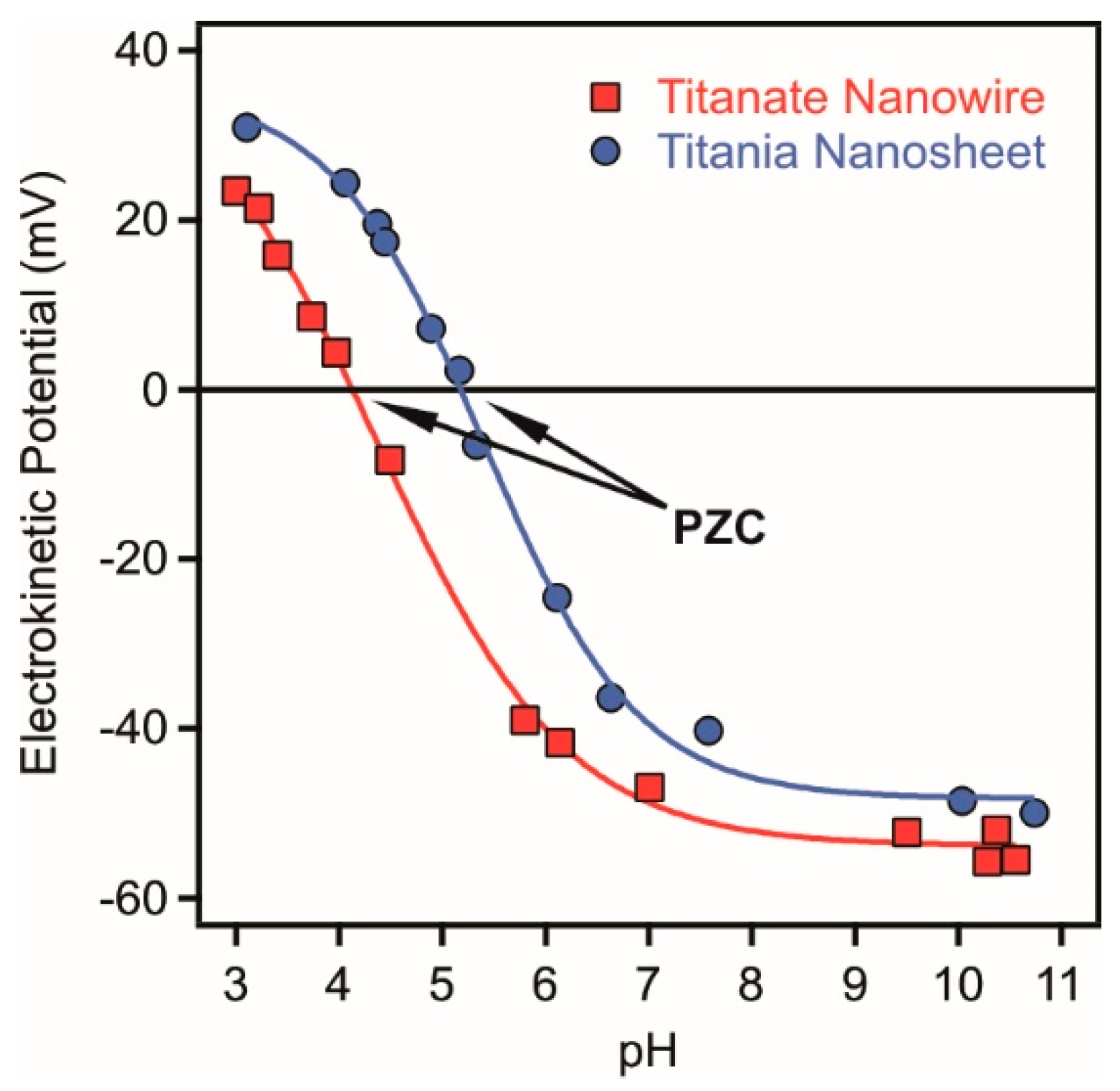
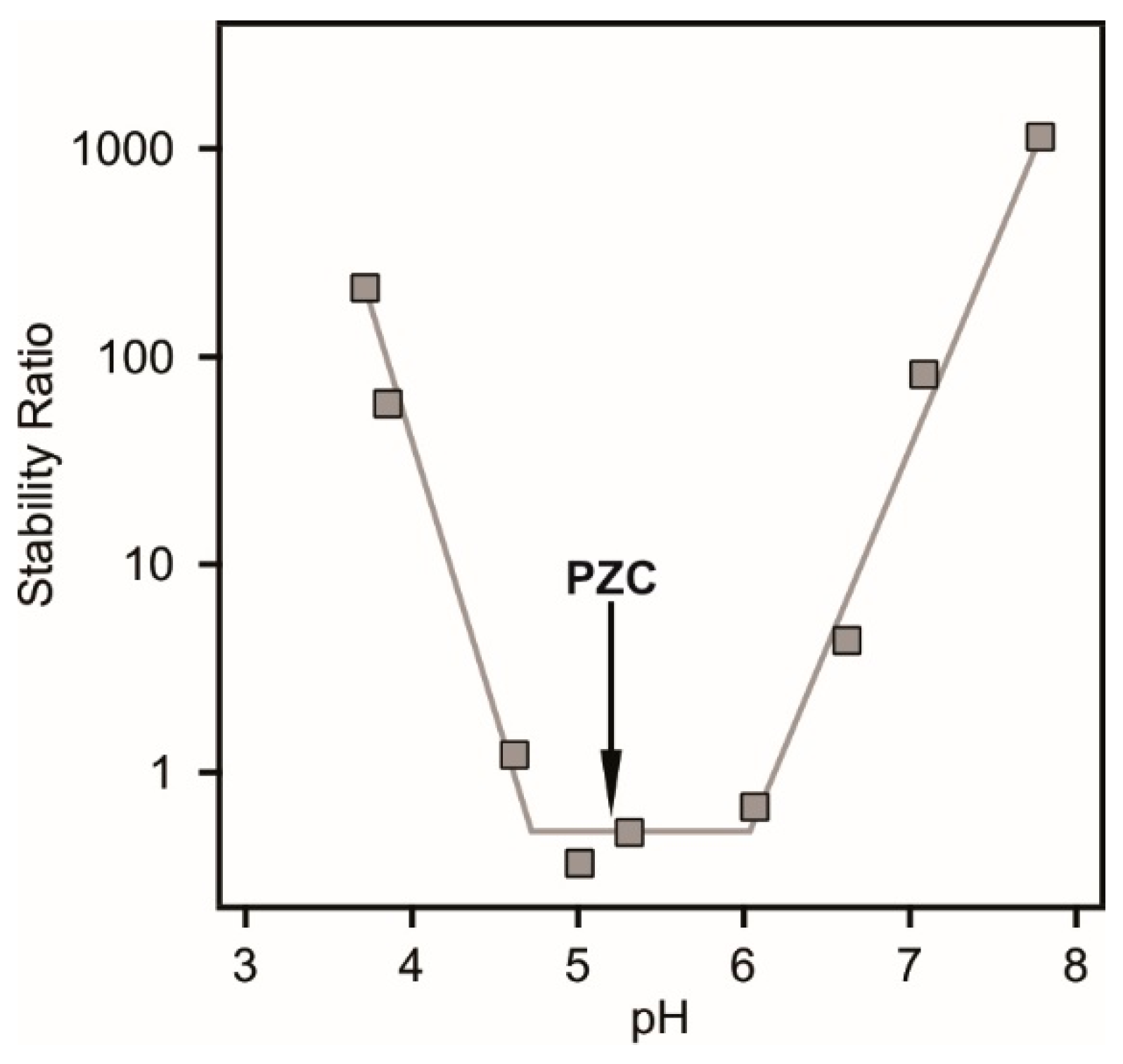

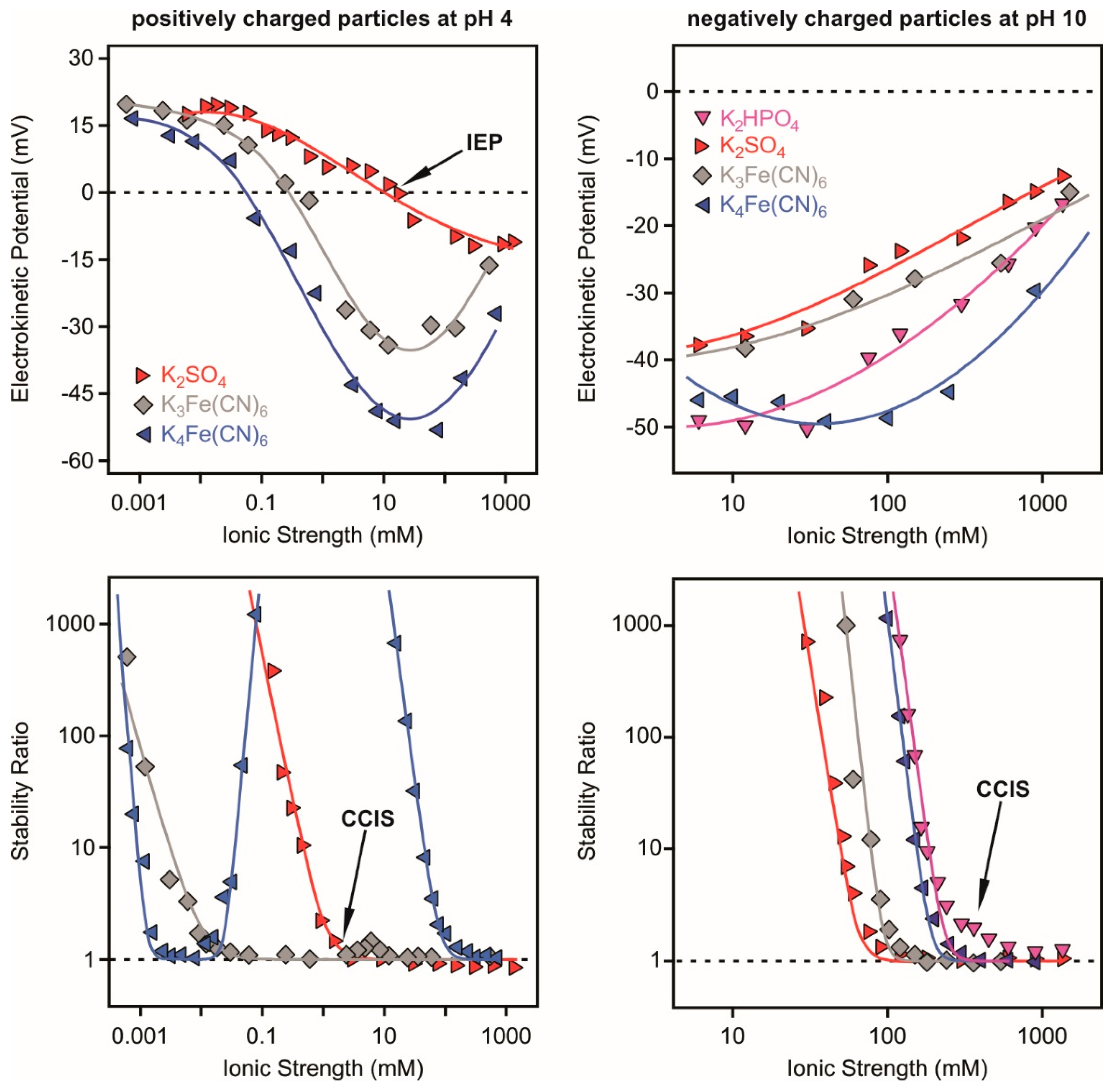
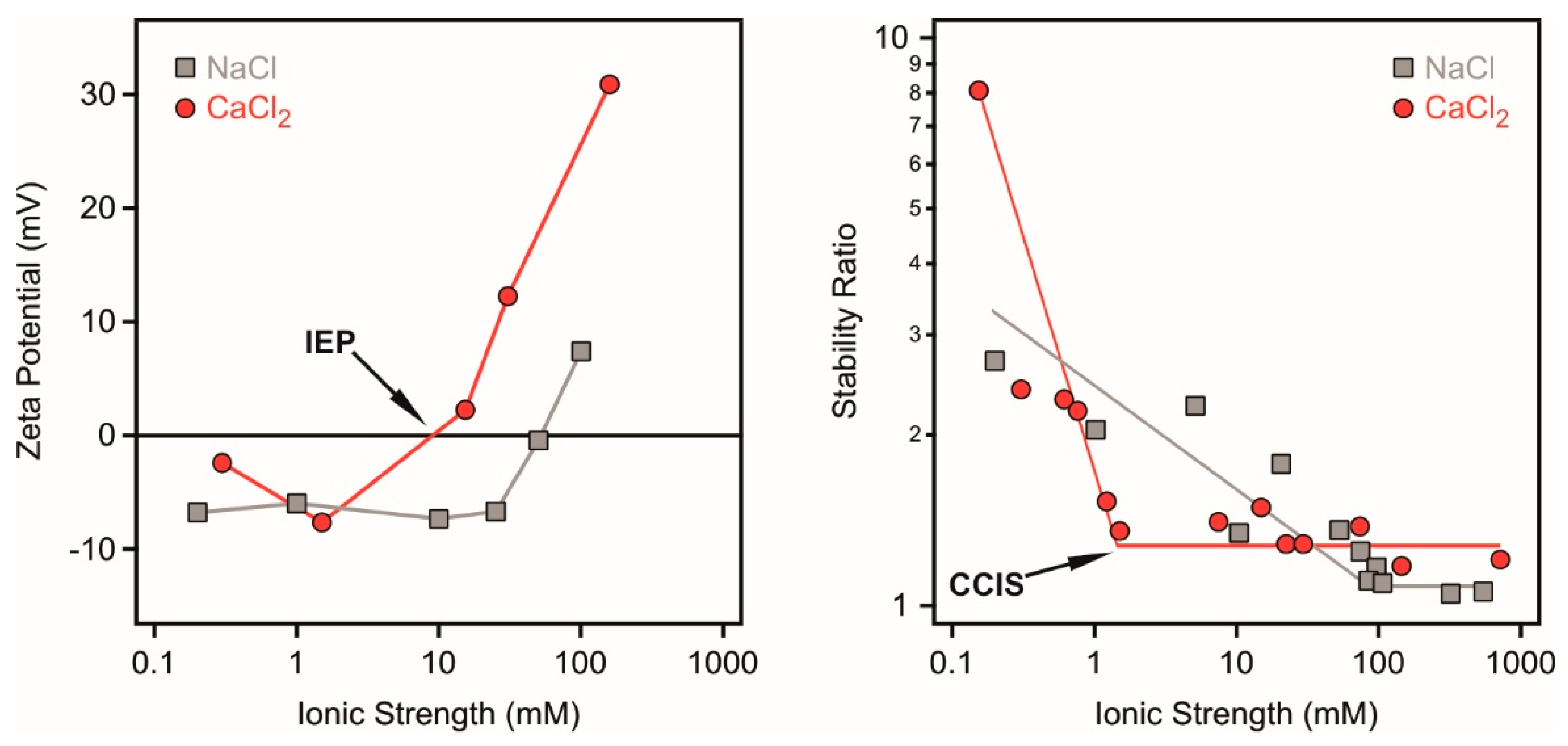
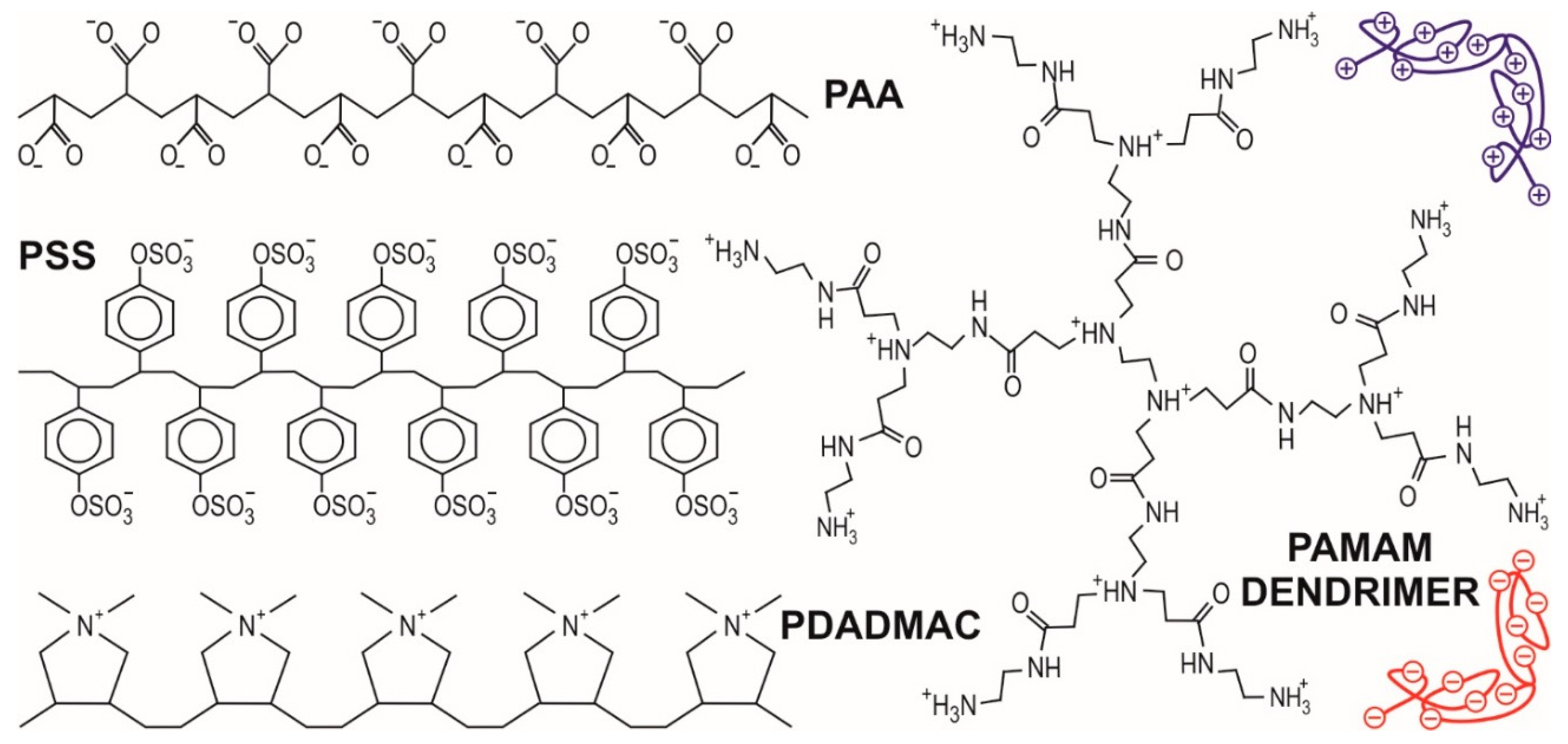


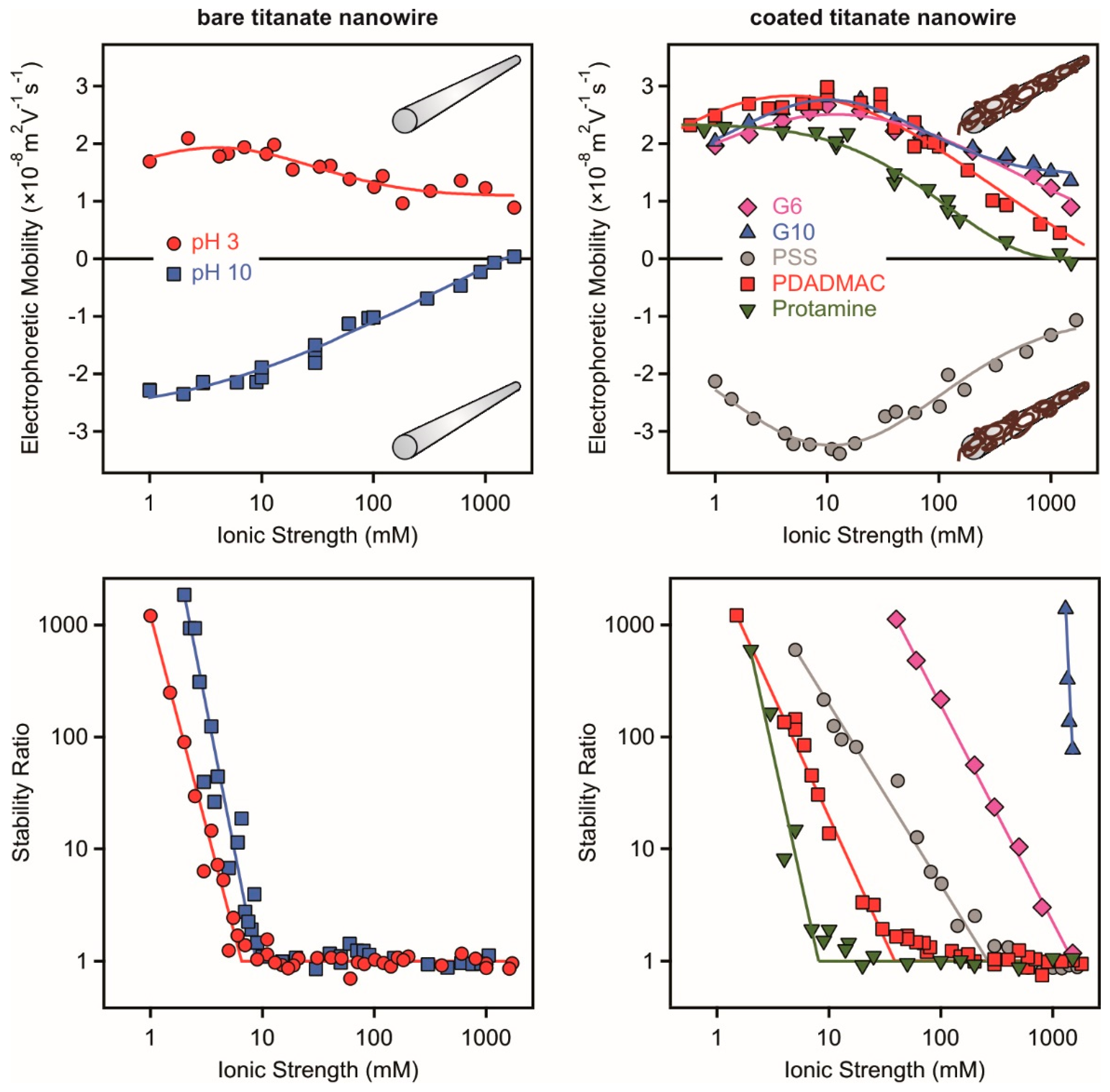
© 2018 by the authors. Licensee MDPI, Basel, Switzerland. This article is an open access article distributed under the terms and conditions of the Creative Commons Attribution (CC BY) license (http://creativecommons.org/licenses/by/4.0/).
Share and Cite
Muráth, S.; Sáringer, S.; Somosi, Z.; Szilágyi, I. Effect of Ionic Compounds of Different Valences on the Stability of Titanium Oxide Colloids. Colloids Interfaces 2018, 2, 32. https://doi.org/10.3390/colloids2030032
Muráth S, Sáringer S, Somosi Z, Szilágyi I. Effect of Ionic Compounds of Different Valences on the Stability of Titanium Oxide Colloids. Colloids and Interfaces. 2018; 2(3):32. https://doi.org/10.3390/colloids2030032
Chicago/Turabian StyleMuráth, Szabolcs, Szilárd Sáringer, Zoltán Somosi, and István Szilágyi. 2018. "Effect of Ionic Compounds of Different Valences on the Stability of Titanium Oxide Colloids" Colloids and Interfaces 2, no. 3: 32. https://doi.org/10.3390/colloids2030032





